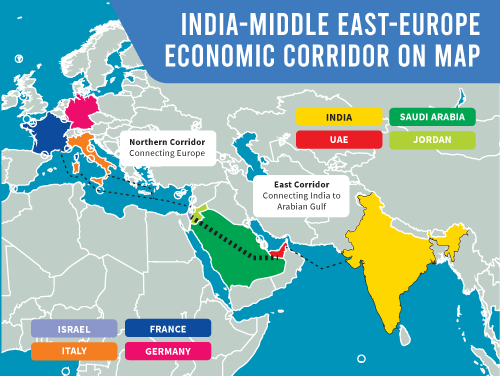At the recent G20 Summit in New Delhi, the world witnessed a historic moment—the signing of the India-Middle East-Europe Economic Corridor (IMEC) Project. This initiative, nestled within the Partnership for Global Infrastructure and Investment (PGII), carries profound geopolitical and economic implications, not only for India but for the entire global landscape.
Unveiling IMEC: A Transformative Project
IMEC is more than just an infrastructure project; it’s a vision of connectivity and cooperation. This ambitious endeavor consists of two principal corridors:
- The East Corridor: This corridor will seamlessly link India to the Arabian Gulf.
- The Northern Corridor: It will connect the Gulf to Europe, bridging continents.
But IMEC is not limited to roads and railways; it envisions an interconnected network that includes an electricity cable, a hydrogen pipeline, and a high-speed data cable. The esteemed signatories of this transformative project include India, the United States, Saudi Arabia, the United Arab Emirates, the European Union, Italy, France, and Germany. The ports to be linked span from India’s Mundra and Kandla to the Middle East’s Fujairah, Jebel Ali, and Abu Dhabi, as well as Saudi Arabia’s Dammam and Ras Al Khair ports. The railway line, a critical component of IMEC, will span from Fujairah port in the UAE to Haifa port in Israel, via Saudi Arabia and Jordan. From Haifa, the route extends to Europe, touching Piraeus in Greece, Messina in South Italy, and Marseille in France.
The Objectives and Aspirations of IMEC
IMEC is a grand vision with multifaceted objectives:
- Enhanced Connectivity: At its core, IMEC seeks to create a seamless transportation network that not only enhances efficiency but also reduces costs, fosters economic unity, generates employment and contributes to the reduction of Greenhouse Gas (GHG) emissions.
- Trade and Connectivity: By facilitating trade and connectivity, IMEC aims to reshape the integration of Asia, Europe, and the Middle East.
IMEC’s Geopolitical and Economic Implications
Geopolitical Significance:
- Countering China’s BRI: IMEC is often seen as a potential counter to China’s Belt and Road Initiative (BRI), offering an alternative narrative in the Eurasian region.
- Integration Across Civilizations: The project strengthens ties and integration across continents and civilizations, providing an opportunity for the U.S. to maintain influence amidst China’s growing presence.
- Breaking Pakistan’s Overland Connectivity Barrier: IMEC bypasses Pakistan, eliminating historical obstacles to India’s overland connectivity to the West.
- Strengthening Arabian Peninsula Ties: IMEC deepens India’s strategic engagement with the Arabian Peninsula, fostering enduring connectivity and stronger political and strategic links.
- Promoting Intra-Regional Connectivity and Peace: IMEC has the potential to promote intra-regional connectivity and could reduce political tensions in the Arabian Peninsula. It holds the promise of becoming an “infrastructure for peace” in the region.
- India’s Role in Africa: This model could extend to Africa, aligning with the U.S. and EU’s plan to develop a Trans-African corridor. This signifies India’s intent to strengthen its engagement with Africa and contribute to its infrastructure development.
Economic Impact:
- Enhanced Trade Opportunities: IMEC presents a transformative opportunity for India to boost economic growth by enhancing its trade connectivity with key regions. It could reduce transit times, making trade with Europe significantly faster.
- Stimulated Industrial Growth: The efficient transport network created by IMEC will encourage industrial growth by facilitating the movement of goods, benefiting regions connected to the corridor.
- Job Creation: As economic activities expand due to improved connectivity, job opportunities will surge across sectors, promoting employment.
- Energy Security and Resource Access: The corridor can ensure secure energy and resource supplies, stabilizing India’s energy sector and supporting its growing economy.
- Facilitating Special Economic Zones (SEZs): Leveraging the corridor to develop Special Economic Zones can attract foreign investment, promote manufacturing, and drive economic growth in designated zones.
Challenges on the Horizon
While IMEC holds immense promise, it is not without its challenges:
- Logistics and Connectivity: Coordinating rail, road, and sea routes across multiple countries demands complex logistical planning and stakeholder coordination.
- Missing Rail Links and Construction: Substantial construction efforts and investments are needed to complete missing rail links, especially in the Middle East.
- Coordination Among Multiple Countries: Coordinating policies and regulations among diverse countries is a significant challenge.
- Potential Opposition and Competition: Opposition or competition from existing transport routes, such as Egypt’s Suez Canal, could pose diplomatic hurdles.
- Cost and Financing: Securing financing for the project is essential, with estimates suggesting substantial costs for development.
The Journey Ahead
To transform IMEC from vision to reality, several key steps must be taken:
- Technical Compatibility: Achieving technical compatibility and standardization across different countries is vital for seamless operations.
- Geopolitical Diplomacy: Balancing the geopolitical interests of participating nations and addressing potential political sensitivities is crucial.
- Environmental Sustainability: Addressing environmental impact concerns and adhering to green practices in construction and operation are critical aspects.
- Security Measures: Implementing robust security measures to safeguard cargo and infrastructure from potential threats is essential.
As IMEC unfolds, it holds the promise of reshaping trade, connectivity, and geopolitical alliances across continents, marking a new era of global cooperation.
Sources: The Indian Express, Outlook India, India Times, The Business Standard.
Image: The Business Standard.
Get in touch with us here.

